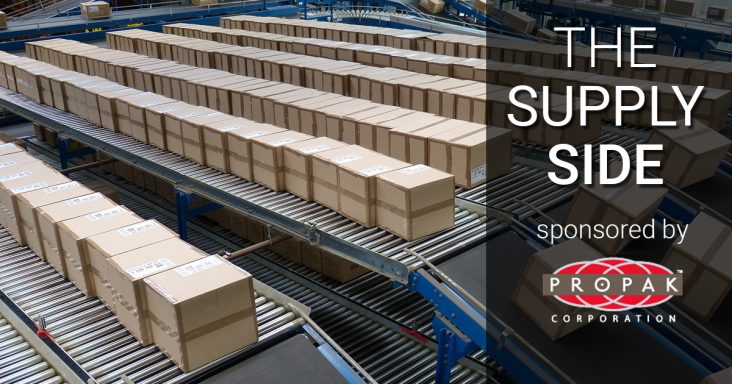The Supply Side: Inflation part of slowing use of online grocery methods
by December 17, 2022 8:34 am 1,145 views

Online grocery sales during the COVID-19 pandemic in 2020 and 2021 showed four to five years of growth in 18 to 24 months. Global and regional retailers added online capacity and tapped into third-party partnerships to meet the unprecedented demand.
Walmart reported e-commerce growth of 90% from the combined years of 2020 and 2021 amid the pandemic. While Walmart does not break out grocery sales, retail insiders told the Northwest Arkansas Business Journal that food and consumable sales and pickup grocery have been a considerable part of Walmart’s online sales growth over the past several years.
But retailers and industry insiders now expect growth to slow for online grocery. Online grocery sales for October totaled $7.8 billion, down 3% compared to the prior year and flat against the preceding month, according to the latest report from BricksMeetsClicks/Mercatus Group.
A 5% reduction in online grocery for curbside pickup and an 11% decline in ship-to-home orders drove the survey results. Mercatus also found consumers ordered less often, with frequency falling 7% for pickup orders and 12% for ship-to-home orders compared with the same month last year.
The effects of inflation were evident in total grocery spending as the average dollars spent on groceries per household during October increased 15% versus last year. During that period, online’s share of spending dipped around 0.50%, accounting for 11.6% of total grocery sales in October, Mercatus reported.
Coresight Research also evaluated online grocery shopping growth patterns as inflation has continued to squeeze household budgets. The research group estimates that U.S. online food and beverage sales will grow 13.8% this year, compared to 18.1% in 2021 and 94.4% in 2020.
Coresight CEO Deborah Weinswig said online grocery shopping is a habit that has stuck for consumers. She expects online food and beverage sales to have sustained multiyear growth in the short-term but said growth rates would be slowed by inflation.
“Although grocery shopping online has its obvious convenience, these benefits come at the cost of markups and, in some cases, added delivery fees, making it less attractive to price-sensitive shoppers,” Weinswig said.
She said frugal shopping behaviors instigated by inflation will leave some online shoppers unwilling to pay additional delivery and service fees. In these instances, Weinswig said behaviors have shifted back toward brick-and-mortar shopping options.
Food prices rose every month for the first eight months of 2022, with the price increases peaking at 13.5% in August, the biggest gain in 43 years, according to the U.S. Bureau of Labor Statistics (BLS). Categories experiencing the most significant price hikes include cereals, dairy and meat products. In August, cereal prices jumped 16.4% and meat, poultry and egg prices rose 10.6%. Food prices were up 12.4% in October compared to the prior year and were up 0.5% from the preceding month.
According to BLS, staples like cereal, meat and dairy prices rose by 12.4%, 15.9% and 15.5%, respectively, from the same month last year.
Kevin Mahn, an analyst with Hennion & Walsh Asset Management, recently noted that consumer spending would likely be strategic in the coming months, including grocery shopping, as prices remain elevated for the foreseeable future. The U.S. savings rate has declined to 3.7%, the lowest rate since 2007. He said that credit card balances rose 15% in the third quarter from a year ago as consumers have continued to spend at the expense of savings. He said the behavior “is not sustainable.”
A report from data marketer Oberlo predicts online grocery sales will hit $147.51 billion this year, spurred on by about 144 million digital shoppers across the U.S. This sales figure would mark a 20.5% annual increase from the previous year, which is the third-biggest growth expected in the forecast period from 2019 to 2025. The most significant annual increase came in 2020 when the online grocery market in the U.S. grew 63.9% year over year.
Oberlo predicted that U.S. online grocery sales are expected to continue growing through 2025, albeit at a marginally slower rate of around 18% on average per year. Weinswig said the future trajectory for online grocery growth is closely tied to consumer behaviors. She said the core group of online grocery shoppers in Coresight’s surveys consists of affluent households, which are better able to absorb higher grocery costs. She also notes that some consumers may find pickup more attractive to avoid extra delivery costs. In contrast, others may return to in-store shopping, where they can use coupons and other promotions. At the same time, those on tighter budgets may shop online occasionally.
Walmart CEO Doug McMillon recently told analysts that the retail giant is seeing more higher-income household shoppers, but everyone is looking for the best values regardless of income.
Weinswig said retailers should leverage their loyalty programs to entice value seekers with exclusive online deals and instant discounts that can be redeemed by those also using grocery pickup and delivery.
“Consolidating discounts and promotions in one location is a trend we have seen from retailers including Amazon, which has app and website pages offering personalized offers and coupons. Those kinds of one-stop pages for deals represent a key advantage for e-commerce players versus stores — where shoppers would have to trek around a store hunting for deals,” Weinswig said.
“Retailers seeking to drive online sales must capitalize on that advantage to convince newly price-sensitive shoppers that e-commerce can be a frugal option in grocery,” she said.
Editor’s note: The Supply Side section of Talk Business & Politics focuses on the companies, organizations, issues and individuals engaged in providing products and services to retailers. The Supply Side is managed by Talk Business & Politics and sponsored by Propak Logistics.
